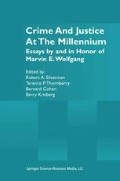Abstract
Our society has witnessed remarkable scientific growth and change since the beginning of the century. Nearly half of us now marveling at landings on the moon were living before the first airplane was flown across the Atlantic. Yet social change is sluggish. The Supreme Court decision on school desegregation did not come about until nearly a hundred years after the Civil War and its intent is yet to be realized.
Access this chapter
Tax calculation will be finalised at checkout
Purchases are for personal use only
Preview
Unable to display preview. Download preview PDF.
Notes
Thorsten Sellin. “The Negro Criminal. A Statistical Note,” The Annals of the American Academy of Political and Social Science (1928), 140:52–64, p. 64 cited.
H. C. Sanborn, “Dr. W. C. George’s The Biology of the Race Problem: A Review,” New York: National Putnam Letters Committee, n.d.
Arthur R. Jensen, “How Much Can We Boost I.Q. and Scholastic Achievement,” Harvard Educational Review,39:1 Winter 1969, pp. 1–123.
As cited in Lee Edson, “jensenism…,” The New York Times Magazine,op. cit., p. 46.
Jerome S. Kagan, Harvard Educational Review,Spring 1969, op. cit., p. 275.
Ibid., p. 308.
Statement of George W. Albee et al., Council of the Society for the Psychological Study of Social Issues, May 2, 1969.
See Martin Deutsch, Irwin Katz, and Arthur R. Jensen (eds.) Social Class, Race and Psychological Development,New York: Holt, Rinehart, and Winston, Inc., 1968, p. 345 and Harvard Educational Review,Spring 1969, op. cit., p. 355.
Robert Rosenthal and Lenore Jacobson, “Self-Fulfilling Prophecies in the Classroom: Teacher’s Expectations as Unintended Determinants of Pupil’s Intellectual Competence.” In Deutsch et al., op. cit., pp. 219–253, especially 234–35.
I. I. Gottesman, “Biogenetics of Race and Class.” In Deutsch et al., op. cit., pp. 11–51. See especially pp. 27–28.
Harvard Educational Review,Spring 1969, op. cit., p. 275.
H. M. Skeels and H. B. Dye, “A Study of the Effects of Differential Stimulation on Mentally Retarded Children,” Proceedings of the American Association on Mental Deficiency,1939, 44, pp. 114–136., Cited by Celia Stendler-LaVatelli, “Environmental Intervention in Infancy and Early Childhood.” In Deutsch et al., op. cit., p. 353.
Theodosius Dobzhansky, “Genetic Differences Between People,” Scientific Research,July 22, 1968, p. 33.
A Kind Word Said for XYY Men,“ The New York Times,May 6, 1969, p. 93.
For the main themes of these authors, see the following works: Albert K. Cohen, Delinquent Boys, Glencoe, Ill.: The Free Press, 1955; Richard Cloward and Lloyd Ohlin, Delinquency and Opportunity, Glencoe, Ill.: The Free Press. 1960; Walter B. Miller. “Lower Class Culture as a Generating Milieu of Gang Delinquency,” Journal of Social Issues (1959), 14:5–19; Frederic M. Thrasher, The Gang, Chicago: University of Chicago Press, 1936; Shaw and McKay, loc. cit., Talcott Parsons, The Social System, Glencoe. Ill.: The Free Press, 1951, especially Ch. VII; Robert K. Merton, Social Theory and Social Structure, Glencoe, III.: The Free Press. 1957.
For discussions of many problems of delinquency among Negroes, see the entire issue of the Journal of Negro Education, (Summer 1959), vol. 28. Also see: Nathan Wright, Jr., Let’s Work Together, New York: Hawthorn Books, Inc., 1968.
Maude M. Craig and Selma J. Glick, “Ten Years’ Experience With the Glueck Social Prediction Table,” Crime and Delinquency, (1963), 9: 249–261.
Philadelphia’s Non-White Population 1960,Report No. 3, Socioeconomic Data, Philadelphia: Commission on Human Relations, December 1962.
These data may be found in reports issued by the Bureau of the Census. See: “Social and Economic Conditions of Negroes in the U.S.,” October 1967, BLS Report #332, Current Population Reports, Series P-23, No. 24, Washington D.C.: U.S. Government Printing Office, pp. 12, 39, 41 and 47; “Consumer Income: Income in 1967 of Families in the United States,” Current Population Reports, Series P-60, No. 59, April 18, 1969, Washington, D.C.: U.S. Government Printing Office, p. 51. We are drawing also from the concise article by Philip M. Hauser, “More from the Census of 1960,” Scientific American, October 1962, pp. 30–37.
Herman P. Miller, “Is the Income Gap Closed? ‘No!”’ The New York Times Magazine,November 11, 1962. “Social and Economic Conditions of Negroes in the United States,” op. cit., p. 15.
Kenneth B. Clark and Lawrence Plotkin, The Negro Student at Integrated Colleges, National Scholarship Service and Fund for Negro Students, 1963.
Social and Economic Conditions of Negroes in the U.S.“ op. cit., p.47.
Lander, op. cit.
Mozell Hill, “The Metropolis and Juvenile Delinquency Among Negroes,” Journal of Negro Education (1959), 28:277–285, p. 284 cited.
Editor information
Editors and Affiliations
Rights and permissions
Copyright information
© 2002 Springer Science+Business Media New York
About this chapter
Cite this chapter
Wolfgang, M.E. (2002). Seeking an Explanation. In: Silverman, R.A., Thornberry, T.P., Cohen, B., Krisberg, B. (eds) Crime and Justice at the Millennium. Springer, Boston, MA. https://doi.org/10.1007/978-1-4757-4883-3_20
Download citation
DOI: https://doi.org/10.1007/978-1-4757-4883-3_20
Publisher Name: Springer, Boston, MA
Print ISBN: 978-1-4419-4930-1
Online ISBN: 978-1-4757-4883-3
eBook Packages: Springer Book Archive

